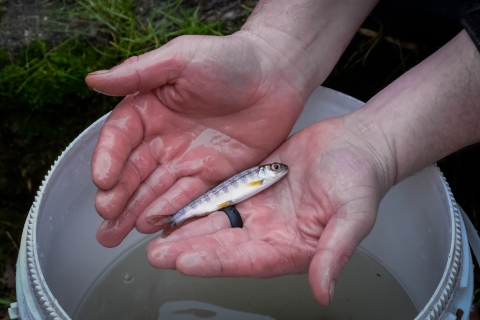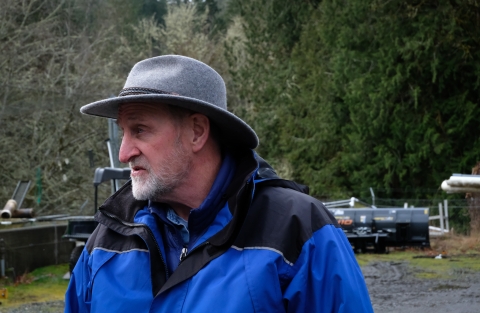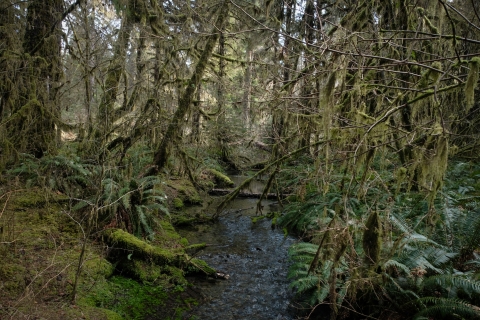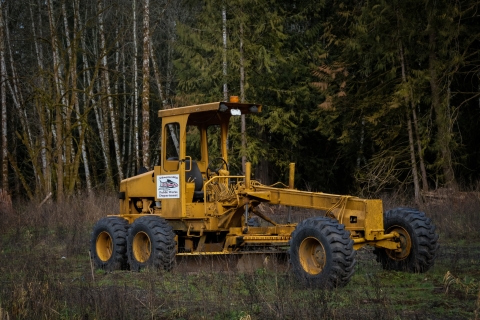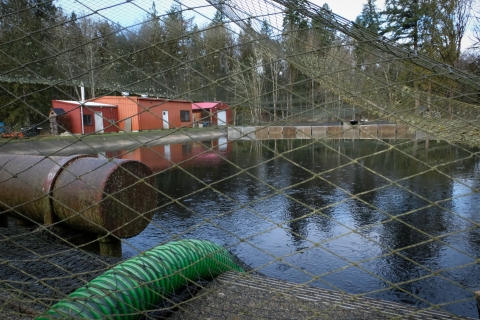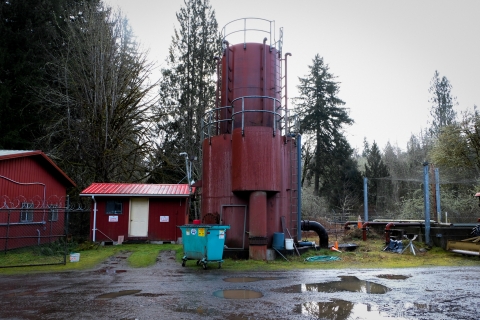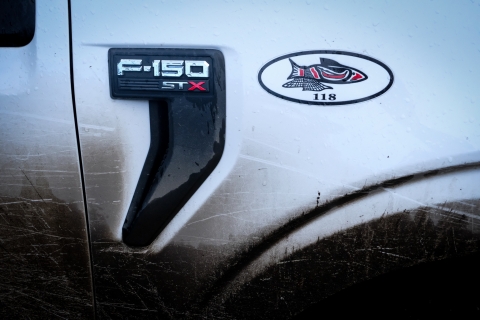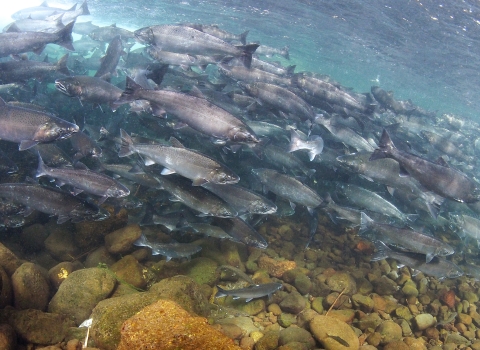At the Nisqually Indian Tribe’s Kalama Creek fish hatchery, feeding time resembles rain.
The snapping mouths of more than one million salmon fry and smolts echo across the dewy clearing on a February morning in 2022 – young coho and Chinook swallowing staccato in their ponds, their smacking gulps rippling atop the water like the surface impact of drizzle: Pop, pop, sploosh, pop, pop!
Backdropped by the greens of ferns unfurled and rainforest moss, Bill St. Jean conducts this morning music: The Nisqually Tribe’s chief enhancement biologist, cloaked in two electric-blue windbreakers and a felt grey trail hat, whisking firebrick fishmeal by the spadefuls through the holes in the ponds’ netting, which protect the fish from birds.
It is a simple breakfast routine St. Jean has completed many times since 1996, when he began rearing salmon, sacred to the Tribe, with the Nisqually’s two hatcheries: Kalama Creek and Clear Creek, the latter located 10 miles downriver.
Even then, nearly three decades ago, salmon runs and stocks in the Pacific Northwest were down significantly compared to historic trends. Despite the work of Indigenous stewards to maintain healthy riparian riparian
Definition of riparian habitat or riparian areas.
Learn more about riparian ecosystems, the century-long impact of mining, damming, logging, overfishing, and development had greatly reduced the amount of healthy habitat within which Pacific salmon spawn and migrate.
In 1999, Puget Sound Chinook salmon were listed as threatened under the Endangered Species Act, and 13 populations of steelhead trout and salmon in Washington state have joined them under the Act in the years since.
These concerning numbers are why fish hatcheries have existed for well over a century – since 1895 – in Washington: To preserve at-risk populations, simultaneously supporting stocks for subsistence users and commercial fishers.
And despite the limitations of hatcheries – compromised genetic diversity among hatchery populations, with offspring tending to have lower fitness levels compared to wild fish – they have provided reliably safe habitat for salmon, offering at least the chance of population stability while fish passage projects remove dams and culverts, restoring wild riparian systems to healthier conditions.
That is, St. Jean says, until the effects of climate change climate change
Climate change includes both global warming driven by human-induced emissions of greenhouse gases and the resulting large-scale shifts in weather patterns. Though there have been previous periods of climatic change, since the mid-20th century humans have had an unprecedented impact on Earth's climate system and caused change on a global scale.
Learn more about climate change began battering natural watersheds and hatchery ponds alike.
Climate Disasters at Sea Impact Inland Ecosystems
Spade in hand, feeding time over, St. Jean points along the pond’s edge and gestures to the hatchery’s entire sloped surroundings. The Olympic Peninsula’s mosaic of rainforest greens and freshwater blues are deeply connected to and reliant upon the health of marine ecosystems hundreds and thousands of miles away.
Because of this precious interconnectedness, the trickle-down effects of oceanic climate change, even at inland hatcheries, are lasting and significant, says Lyall Bellquist, a senior fisheries scientist with the California Oceans Program at The Nature Conservancy and Scripps Institution of Oceanography.
“If a fishery disaster occurs, there is a very good chance that there are broader ecosystem impacts occurring as well,” Bellquist says. “In the 2014 to 2016 west coast marine heatwave, we know this oceanographic anomaly impacted entire food webs. In the case of salmon, we saw extreme drought lead to dire conditions on the Klamath River, causing Chinook salmon mortality and alarmingly low run sizes.”
Coho stocks in the Puget Sound were also hit hard, St. Jean says, prompting fishery disaster declarations in the region, including at Kalama Creek in 2015. “Survival was about one-third of what it historically was,” St. Jean says in March 2023.
Per a 2021 study authored by Bellquist, 84.5% of fishery disasters nationwide were either partially or entirely attributed to “extreme environmental events,” including marine heatwaves. The study also found that from 2014 to 2019, these events reflected 95.3% of direct revenue loss.
It took six years for the Kalama Creek hatchery to receive federal funding as a result of the disaster, a trend that isn’t uncommon when applying for relief. Bellquist’s fishery disaster research found that “limited syntheses of disaster impacts to Indigenous communities are available,” despite these communities being “intimately connected with salmon populations for generations.”
The study also recommended that “knowledge of the disruptions in such cultural relationships should be a necessary part of efforts to mitigate the totality of fishery disaster impacts.”
“These are all impacts that are linked to a complex extreme environmental event in the Pacific Northwest, but these types of events have recently happened in several places around the world,” Bellquist says.
Extreme Weather, Warmer Waters, and Weaker Flows
It isn’t just marine disasters that have been cause for concern. The 2020 “Pineapple Express” rain event ushered three straight weeks of storms, St. Jean says. Flooding brought a foot of water over the top of the Kalama coho pond, though the hatchery “lucked out” without losing “significant amounts of fish,” though they did incur $75,000 in structural damages and equipment repairs, he says.
Hot water and low flows were once again attributed to high mortality rates in September 2021 in the nearby South Fork Nooksack River, where 2,500 Chinook – of a run of 3,000 – died. And last winter, freshwater pathogens – which thrive in warmer, slower waters – were responsible for the deaths of hundreds more Chinook, the Northwest Indian Fisheries Commission reported.
“Hatcheries that are drawing water off the Nooksack River are having huge pre-spawning mortality issues in both wild and natural fish coming back,” St. Jean says. “River temperatures [reaching] 70 degrees – that’s lethal.”
These conditions – warm waters and extreme precipitation events – have been prevalent at the Nisqually’s second fish hatchery, Clear Creek, producing 3.5 million Chinook smolts and up to 600,000 coho yearlings each year. Since 2017, irregular precipitation and development – “more buildings, more wells drawing water” – has made low flows lower within many of the region’s watersheds, including streams and channels from which the hatchery receives and recycles its water.
“The lake gets really warm in the summer with reduced flows,” St. Jean says. “We’re seeing 64 to 65-degree water when adult [salmon] are coming back, causing pre-spawning mortality issues.”
Future Proofing, with Risks
The challenges facing Clear Creek hatchery are mounting, and solutions are expensive. To mitigate the effects of climate change, investments in water reuse capacity and infrastructure are needed, which St. Jean estimates would cost between $15 million to $20 million.
The good news: Designs for these improvements are already becoming a reality at Kalama Creek, where an estimated $12 million of federal, state, Bipartisan Infrastructure Act, and Tribal funds are being used to future-proof the hatchery. “Kalama Creek has not seen reduced flows yet, but we’re rebuilding the facility to prepare for that,” St. Jean says.
Ground broke in late 2022, with a series of improvements planned. A complex of water reuse tanks – which remove waste from the hatchery, sterilize and aerate the water for reuse and shine UV light that kill parasites – are being installed. Twenty circular tanks will better integrate natural Chinook populations with hatchery fish, with the goal of enhancing genetic diversity.
To mitigate the effects of extreme rain events, the entire hatchery will be elevated about three feet and moved 50 feet away from the creek. Both the generator and power transformer will be lifted four feet higher.
“We’re going to be able to raise twice as many salmon on the same amount of water as before,” St. Jean says.
Still, in a climate-changing environment, risks remain. A dependence on generators without energy backups, difficulties receiving funding, and the trends of warming waters and weather continue to put pressure on hatcheries, once considered a solution for the problem of wild habitat degradation.
“When bad things happen in fish hatcheries,” St. Jean says, “fish are killed.”
The Alaska, Pacific, and Pacific Southwest Regions of the U.S. Fish and Wildlife Service have collaborated to tell stories of climate-related challenges, adaptations, and outlook for hope for Pacific salmon species from multiple perspectives. Learn more about the efforts of the Service, Tribes and other partners to help Pacific salmon overcome the challenges they face due to climate change: New Challenges in the Struggle to Save Pacific Salmon

